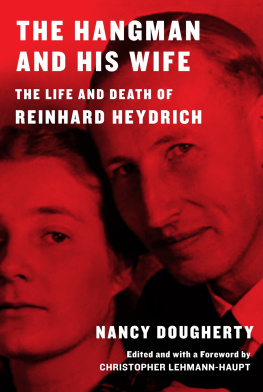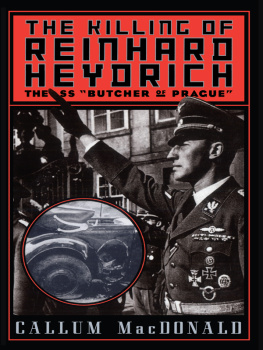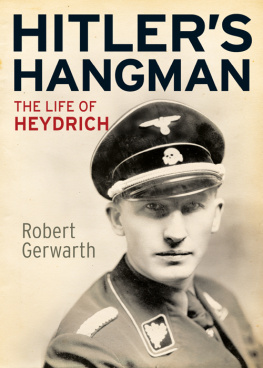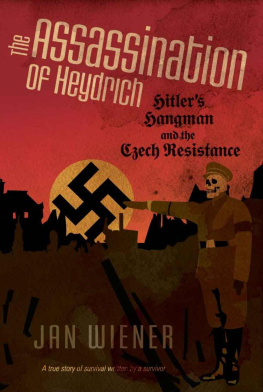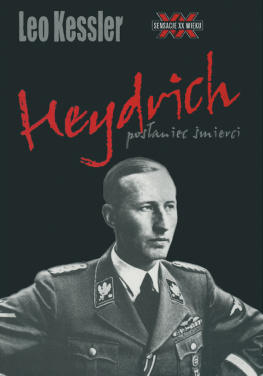Preface
In March 2013, I was at the Potteries Museum in Stoke-on-Trent with my son. We were asked if wed like to see a film about the village of Lidice, destroyed by the Nazis during the Second World War. I didnt know the story of Lidice, and assumed it would be similar to that of Oradour-sur-Glane in France, the site of an infamous massacre.
The film showed that Reinhard Heydrich, a senior Nazi and one of the main architects of the Holocaust, was assassinated in 1942. In retribution, the men of Lidice were shot, the women and children were sent to an extermination camp, and the buildings were destroyed. So far, the story was depressingly similar to that of Oradour-sur-Glane, although differing in detail.
The story didnt end there, and so the film continued. The buildings were bulldozed. The rubble was taken away. The remains in the cemetery were dug up. The stream that ran through the village was rerouted. The area was landscaped. When they were finished, there was no sign that a village had ever been there. This was exactly what Hitler had ordered. The destruction of the village and the murder of its inhabitants werent enough; he wanted the memory of Lidice to die. It was to be as if the village had never existed.
After the viewing, I spoke to Nicola Winstanley, one of the artists of the Unearthed 2013 project. She told me the remarkable story of what happened next. How the generosity of North Staffordshires miners meant that Lidice was rebuilt after the war. Hitler died, but in direct opposition to his orders, Lidice lives.
It is my sincere hope that this short book will help spread the story of Lidice and North Staffordshires miners. Its an incredible story of outrageous cruelty, but also of tremendous compassion and generosity. We should remember the atrocity. It is when we forget these things that we allow them to happen again. We should also remember the miners and their wonderful generosity. They showed us that humans can be good and kind, as well as cruel. Let us remember their story as an inspiration and example to ourselves and our children.
Russell Phillips
Stoke-on-Trent, June 2016

The author's tag on the Unearthed sculpture
Acknowledgements
In the UK, the story of Stoke-on-Trent's connection to Lidice was forgotten for many years, lost to the expediencies of Cold War politics. Alan Gerrard discovered the story in 2010. Since then, he and his wife Cheryl have worked to restore that memory. Alan gracefully agreed to check this manuscript for factual errors.
Nicola Winstanley and Sarah Nadin are the artists who created the Unearthed sculpture. In the months before the sculpture was unveiled, they worked to raise awareness of the Lidice Shall Live campaign.
It is through the efforts of these people that I and others became aware of the Lidice story. Without them, this book would not exist. I offer grateful thanks to them for the work that they have done to spread awareness of the story.
Elizabeth Carver provided invaluable help improving the initial manuscript, making it a much better read.
Any errors or omissions in the final book, however, are my own.
Reinhard Heydrich
Reinhard Heydrich was born on 7th March 1904. A persistent, though untrue rumour held that his father was Jewish. After being widowed, Heydrichs grandmother had married a man named Sss. Sss wasnt Jewish, but it was a common name among Jews, leading many to assume that he had Jewish ancestry. Even before the Nazis rose to power, anti-Semitism was rife in Germany. Consequently, the rumour caused problems for the Heydrich family.
In 1919, the fifteen-year-old Heydrich joined the Mracker Freikorps, a right-wing paramilitary group formed to fight against revolutionaries. Later, he and his father joined the Halle volunteers, a home defence group. Heydrich also joined the nationalist and anti-Semitic Deutscher Schutz und Trutzbund.
In March 1922, Heydrich joined the navy as an officer cadet. Unfortunately for him, another cadet from Halle passed on the rumour of his Jewish ancestry. This earned him the nickname "blond Moses". Despite this, he secured promotion and received good reports. He worked in signals and learned English, French, and Russian.
In 1923 and 1924, Heydrich served on the SMS Berlin, where Wilhelm Canaris was the first officer. The two men struck up a friendship, and Heydrich was a frequent guest at Canaris house. Heydrich appeared to be set on a future in the navy. By the time he proposed to his future wife, Lina von Osten, in December 1930, he had been promoted to first lieutenant.
The German navy had very strict codes of conduct for its officers. In 1931, Heydrich was brought before a court of honour to face charges of breach of promise, brought by an ex-girlfriend. He claimed that she had arrived at his rooms one night, asking for lodging. According to Heydrich, she had stayed the night, but nothing had happened between them. The prosecution held that Heydrich had invited her to his rooms because of the expense of hotels. She had agreed out of necessity, but resisted his advances.
Although Lina believed Heydrich, the court found against him, and he was discharged in April 1931. He appealed, but the courts decision was upheld. He was deeply upset by the loss of his career and standing as an officer and a gentleman. It also affected his personal relationships. His mother blamed Lina, and the relationship between the two women never recovered. Heydrich had gone from a promising career in the navy to having no prospects, and Linas parents withdrew their consent for marriage. Lina refused to break off the engagement, although the wedding had to wait until Heydrich secured employment.
Lina and her parents were members of the Nazi party, and Heydrich also joined in June 1931. Himmler, the head of the SS, was planning a counter-intelligence division. A friend of the von Osten family secured an interview for Heydrich. Himmler was impressed, and Heydrich started his new job on 1st August. He showed a talent for the work, quickly building up a network of spies and informants, which led to rapid promotion. In December 1931, he married Lina and was promoted to Sturmbannfhrer (major) as a wedding gift from Himmler.
Within a few months of the wedding, rumours of Heydrichs Jewish ancestry surfaced again. Some of his previous Navy colleagues told the Gauleiter (regional party leader) in Halle that Heydrichs real name was Sss, and that he had Jewish ancestry. The Gauleiter dutifully reported the accusation to Nazi party headquarters. An investigation was launched into the Heydrich family, which concluded that they were "free from any coloured or Jewish blood". Nonetheless, the rumours persisted. Wilhelm Canaris even claimed to have copies of documents proving Heydrichs Jewish ancestry, though he never produced them.
In spite of these attempts to discredit him, Heydrichs career continued to progress. In July 1932 Himmler promoted him to Standartenfhrer (colonel) and appointed him head of the SS security service, the SD (Sicherheitsdienst). In July 1933 Heydrichs first child, Klaus, was born. Himmler and Ernst Rhm, the head of the SA (the Nazi partys paramilitary wing, known as "Brownshirts"), were the childs godfathers.




